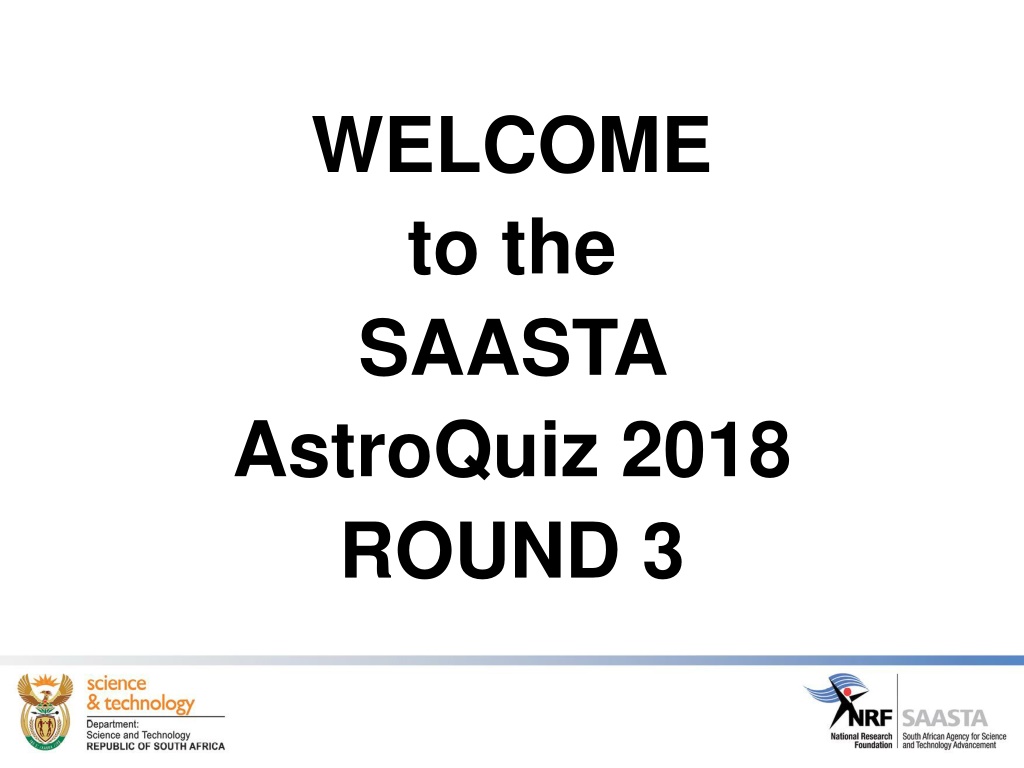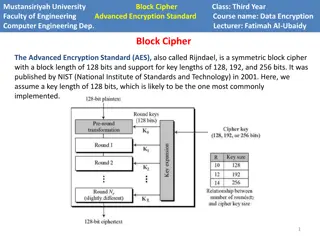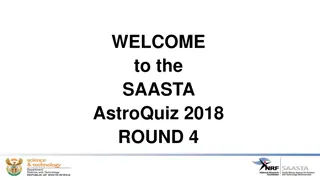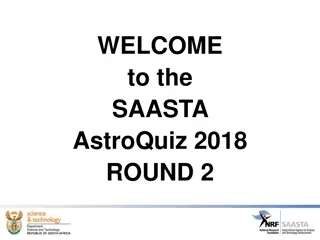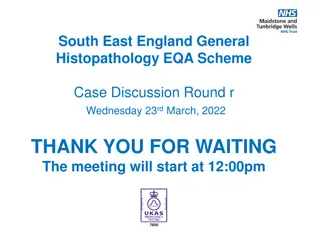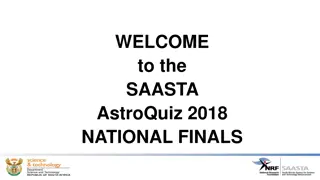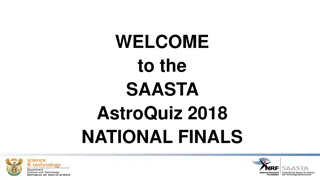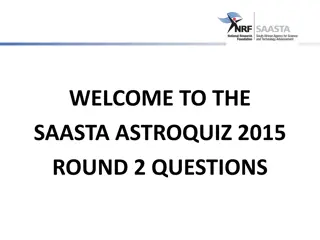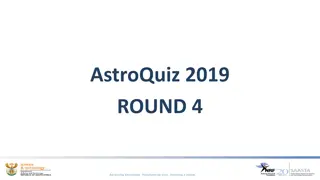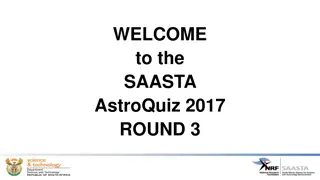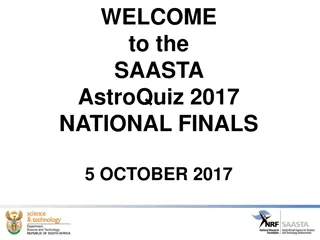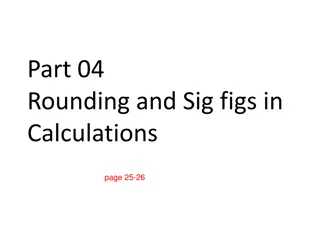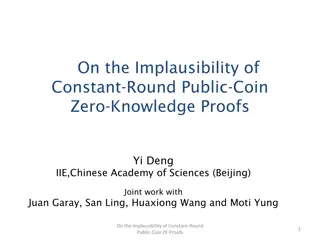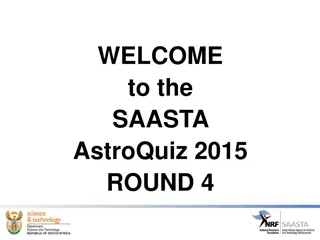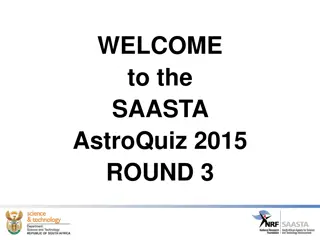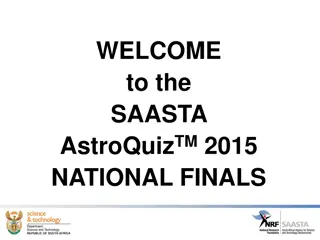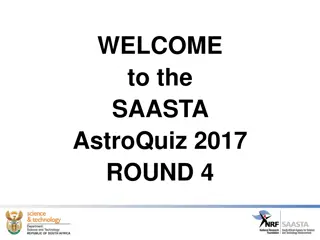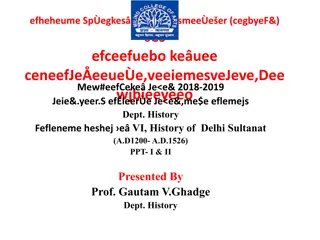SAASTA AstroQuiz 2018 Round 3
Test your astronomical knowledge with quick-fire questions in the SAASTA AstroQuiz 2018 Round 3. Can you answer questions about galaxies, stars, black holes, planets, and more in just 60 seconds? Challenge yourself and see how well you do!
Download Presentation

Please find below an Image/Link to download the presentation.
The content on the website is provided AS IS for your information and personal use only. It may not be sold, licensed, or shared on other websites without obtaining consent from the author. Download presentation by click this link. If you encounter any issues during the download, it is possible that the publisher has removed the file from their server.
E N D
Presentation Transcript
WELCOME to the SAASTA AstroQuiz 2018 ROUND 3
RULES You only have 60 seconds to answer the questions. You are allowed to discuss amongst yourselves. Calculators may be used if needed. No internet is to be used, therefore the use of cellphones is also prohibited. The judge s decision is final.
QUESTION 1 A galaxy contains stars only. A.True B. False
QUESTION 2 Very massive stars can form a white dwarf. A. True B. False
QUESTION 3 Light can escape from a Black Hole A. True B. False
QUESTION 4 The sun has magnitude of -26.8. A.True B. False
QUESTION 5 From where can one detect the presence of a Black Hole? A. the light it emits B. the noise it makes C. from the effect of gravity on its surroundings D. None of the above
QUESTION 6 A light year is a measure of_____ A.time B.light C.distance D.speed
QUESTION 7 Arrange the following in terms of increasing distance from Earth. A. Makemake, Eris, Ceres, Pluto B. Eris, Pluto, Ceres, Makemake C. Ceres, Makemake, Eris, Pluto D. Ceres, Pluto, Makemake, Eris
QUESTION 8 Which statement describes the atmosphere of the planet correctly? A. Venus atmosphere contains mostly carbon dioxide Mercury s atmosphere contains mostly nitrogen Earth s atmosphere contains mostly oxygen Saturn s atmosphere contains mostly helium B. C. D.
QUESTION 9 The three most abundant gases found in Uranus' atmosphere are __ A. Hydrogen, Helium & Nitrogen B. Hydrogen, Helium & Methane C. Hydrogen, Helium & Ammonia D. Hydrogen, Helium & Oxygen
QUESTION 10 Proxima Centauri is approximately 4,22 light years away from the Earth. How far is it in km given that 1 light year = 9,46 x 1012km? A. B. C. D. 2,241 x 1013 39,92 x 1013 2,241 x 1012 3,992 x 1013
QUESTION 11 The imaginary line that divides the world into southern and northern hemispheres is the ___ A. Prime Meridian B. Tropic of Capricorn C. Equator D. Tropic of Cancer
QUESTION 12 The imaginary line that divides the world into eastern and western hemispheres is the _____ A. Prime Meridian B. Tropic of Capricorn C. Equator D. Tropic of Cancer
QUESTION 13 Blue stars are on average younger than red stars. A. True B. False
QUESTION 14 If the Moon revolves the Earth at a speed of 1,02 km/h, approximately how long will it take to go completely around the Earth? A. 27, 3 days B. 40 days C. 27,3 years D. 40 years
QUESTION 15 A combination of the following factors causes the Moon to appear the same size in the sky as the Sun. A. B. C. D. Its appearance and shape Its size and distance from the Earth Its size and colour from the Earth Its movements around the Earth and the Sun
QUESTION 16 During a total solar eclipse the Moon s shadow causes a narrow path of total darkness across the Earth. What is this path of total shadow called? A. Umbra B. Penumbra C. Corona D. Luna
QUESTION 17 When did the two Mars Rovers start their exploration of the surface of planet Mars? A. January 2004 B. August 1989 C. May 2001 D. April 2006
QUESTION 18 Which is the furthest place from Earth that a spacecraft has ever landed? A. Pluto B. Saturn C. Titan D. Venus
QUESTION 19 On Earth the Sun rises in the east and sets in the west. What happens on Venus? A. Because of the planet s thick atmosphere, we will never know from where the Sun sets and rises on Venus B. The Sun also rises in the east and sets in the west C. The Sun rises in the west and sets in the east D. Venus does not rotate around its axis, so there is no sunrise or sunset
QUESTION 20 The Moon is the Earth s natural satellite. It is a rocky body orbiting our planet at a mean distance of approximately______ A. 308 000 km B. 450 000 km C. 380 000 km D. 300 000 km
QUESTION 21 What type of satellite is the South African satellite, SumbandilaSat? A. Communication B. Earth observation C. Weather D. Navigation
QUESTION 22 What colour are the coolest stars? A.Green B. Blue C. Yellow D.Red
QUESTION 23 Equinox refers to days when the day and night have equal lengths. How many times a year do we experience this? A. 4 times B. 3 times C. 2 times D. 12 times
QUESTION 24 Tides occur due to _________ A. The pull of gravity of the Earth on that of the Sun B. The pull of gravity of the Sun on the Earth C. The pull of gravity of the Earth on the Moon D. The pull of gravity of the Moon and the Sun on the Earth's oceans
QUESTION 25 If Earth = ; Universe= ; Solar system= and Galaxy = then which relationship is correct? A. B. C. D.
QUESTION 26 The time required for the Moon to complete a cycle of phases when viewed from the Earth is approximately a ______ A. week B. month C. year D. day
QUESTION 27 A solar eclipse occurs during the night whilst a lunar eclipse occurs only during the day. A. True B. False
QUESTION 28 The phase of the Moon that one sees depends on ______ A. The Moon s position and where you are on Earth's surface B. How much of the sunlit side of the Moon faces Earth C. How much of the Moon's surface is lit by the sun D. Whether or not an eclipse is occurring
QUESTION 29 When do we experience the highest tides? A. B. During the Moon's first quarter phase When the Sun, Earth and Moon are nearly in a line During the Moon's third quarter When the Moon is at a right angle to the Sun C. D.
QUESTION 30 Approximately how long does it take light to travel from the Sun to the Earth? A. 1 minute B. 8 minutes C. 1 hour D. 24 hours
THANK YOU FOR PARTICIPATING ALL THE BEST!
PLEASE NOTE: There is no need to break the ties here, please let them continue to Round 4.
